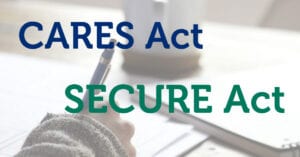Relief for retirees – tax law changes impact required minimum distributions
Buried in two major pieces of legislation signed into law since December are significant changes for anyone with retirement accounts which affect when you must begin taking distributions. Fortunately, these changes help retirees by relaxing some of the requirements but also leads to confusion.
The first law signed into law on December 20, 2019 was the SECURE Act which (among other changes) increased the age when money must be withdrawn from various types of retirement accounts. In order to qualify for the new rules, someone would have had to be younger than age 70 1/2 as of the end of 2019 (i.e. born after June 30, 1949).
Previously, most people needed to start taking distributions at age 70 1/2 from their retirement accounts [such as IRAs, 401(k)s and 403(b)s]. Under the new SECURE Act rules, distributions don’t need to begin until the year someone turns age 72 (although technically, the withdrawal itself doesn’t have to occur until April 1st of the following year).
If you’re wondering whether this change affects you for 2020, don’t worry. The second piece of legislation signed into law on March 27, 2020 supersedes these changes (at least for this year). The CARES Act was the $2 trillion stimulus bill passed by Congress which included a waiver of required distributions from just about all retirement accounts for 2020. Similar to the 2009 waiver after the last financial crisis, normal rules for taking distributions don’t apply this year. Therefore, no one has mandatory distributions in 2020 (with a few exceptions)!
Based on additional guidance from the IRS, a withdrawal taken since February 1st can be returned by July 15th to essentially reverse the distribution (assuming someone didn’t need the money in the first place).
For those individuals who don’t need their distributions (perhaps because Social Security and pensions are sufficient to cover their living expenses), there are several strategies worth considering. First, the rules for making Qualified Charitable Distributions (QCDs) from your IRAs starting at age 70 1/2 did not change so even though you’re not required to take a withdrawal this year, you may consider supporting charitable causes with your IRA (versus writing a check which typically results in you paying more taxes than if you used a QCD).
Another strategy would be to convert part of your Traditional IRA to a Roth IRA which still results in paying taxes this year on the distribution but the money in the Roth IRA and its future growth would be tax-free. Normally, amounts you’re required to distribute are not eligible for a Roth conversion so this year presents a unique opportunity.
Finally, these strategies are not mutually exclusive. In other words, you could support worthwhile causes and reduce your future taxes. Regardless of what you decide to do, learning about changes in the tax laws is essential to responsibly managing your personal finances.






